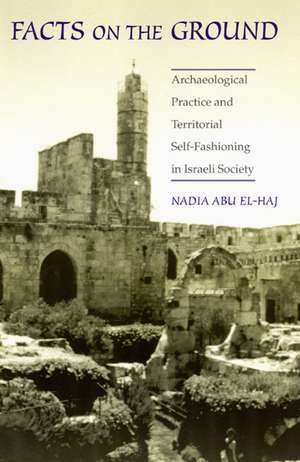Facts on the Ground – Archaeological Practice and Territorial Self–Fashioning in Israeli Society
Autor Nadia Abu El–hajen Limba Engleză Paperback – 3 mar 2002
Archaeology in Israel is truly a national obsession, a practice through which national identity—and national rights—have long been asserted. But how and why did archaeology emerge as such a pervasive force there? How can the practices of archaeology help answer those questions? In this stirring book, Nadia Abu El-Haj addresses these questions and specifies for the first time the relationship between national ideology, colonial settlement, and the production of historical knowledge. She analyzes particular instances of history, artifacts, and landscapes in the making to show how archaeology helped not only to legitimize cultural and political visions but, far more powerfully, to reshape them. Moreover, she places Israeli archaeology in the context of the broader discipline to determine what unites the field across its disparate local traditions and locations.
Boldly uncovering an Israel in which science and politics are mutually constituted, this book shows the ongoing role that archaeology plays in defining the past, present, and future of Palestine and Israel.
Boldly uncovering an Israel in which science and politics are mutually constituted, this book shows the ongoing role that archaeology plays in defining the past, present, and future of Palestine and Israel.
Preț: 266.51 lei
Nou
Puncte Express: 400
Preț estimativ în valută:
50.100€ • 53.65$ • 42.23£
50.100€ • 53.65$ • 42.23£
Carte tipărită la comandă
Livrare economică 14-28 ianuarie 25
Preluare comenzi: 021 569.72.76
Specificații
ISBN-13: 9780226001951
ISBN-10: 0226001954
Pagini: 364
Ilustrații: 20 halftones, 4 maps
Dimensiuni: 167 x 225 x 27 mm
Greutate: 0.5 kg
Ediția:1
Editura: University of Chicago Press
ISBN-10: 0226001954
Pagini: 364
Ilustrații: 20 halftones, 4 maps
Dimensiuni: 167 x 225 x 27 mm
Greutate: 0.5 kg
Ediția:1
Editura: University of Chicago Press
Notă biografică
Nadia Abu El-Haj is an assistant professor in the Department of Anthropology at the University of Chicago.
Cuprins
List of Illustrations
Acknowledgments
Author's Note
1. Excavating Archaeology
2. Scientific Beginnings
3. Instituting Archaeology
4. Terrains of Settler Nationhood
5. Positive Facts of Nationhood
6. Excavating Jerusalem
7. Extending Sovereignty
8. Historical Legacies
9. Archaeology and Its Aftermath
10. Conclusion
Notes
Bibliography
Index
Acknowledgments
Author's Note
1. Excavating Archaeology
2. Scientific Beginnings
3. Instituting Archaeology
4. Terrains of Settler Nationhood
5. Positive Facts of Nationhood
6. Excavating Jerusalem
7. Extending Sovereignty
8. Historical Legacies
9. Archaeology and Its Aftermath
10. Conclusion
Notes
Bibliography
Index
